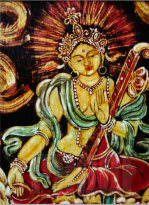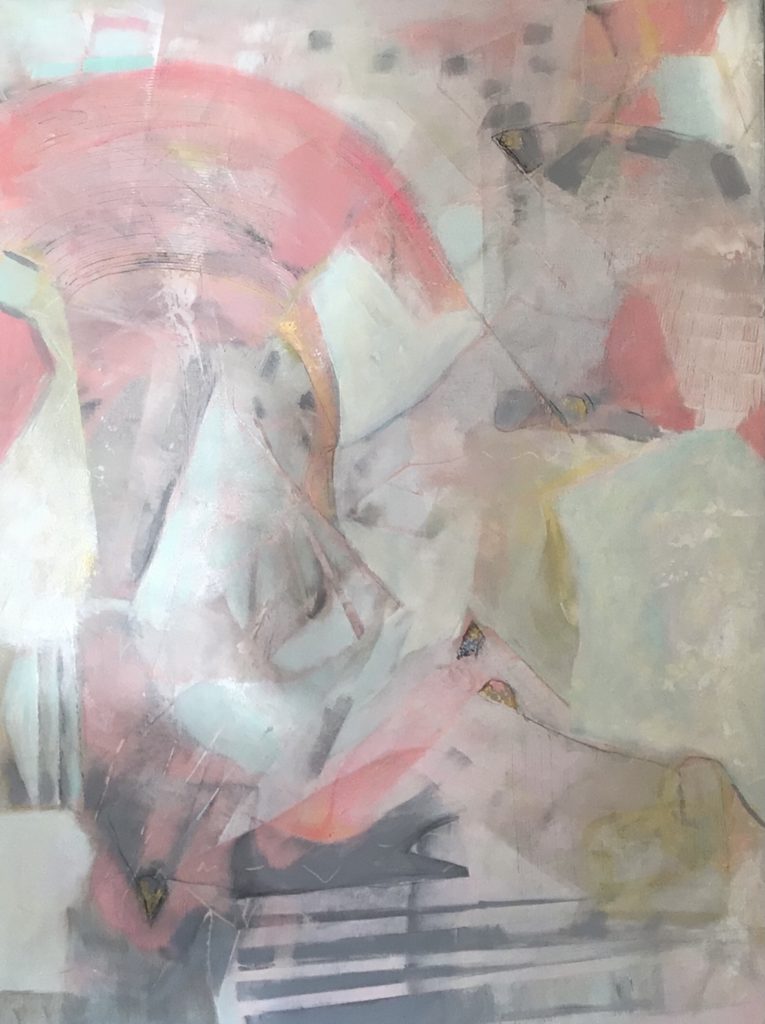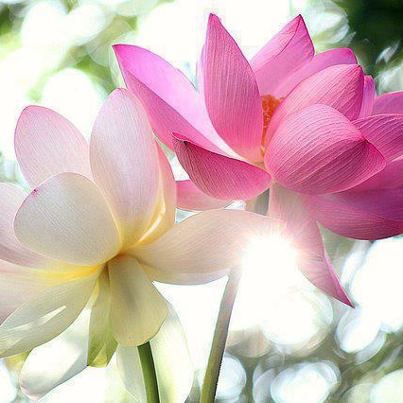Yoga Therapy and Ayurveda belong together.

When we think of Yoga as therapy we must have a method of assessment, there must be some medical model that prescribes Yoga as the healing modality. Some of our Western doctors are beginning to do that but largely they look at Yoga as being a physical exercise that can be adapted for various illnesses, they are often not seeing Yoga as the spiritual practice that it is. An Ayurvedic medical perspective, on the other hand, can view the person in their wholeness, and long before they have become chronically ill, recommend many lifestyle and dietary changes, as well as spiritual practices and yogic techniques.
Yoga is not a medical system; it aims at relieving spiritual suffering through understanding the Kleshas which are the afflictions or obstacles that lead us away from our pure nature. Yoga understands that it is through false identification with ourselves as limited bodies and minds that we suffer. When our ignorance is removed, we identify with our true self and true nature of pure consciousness. Most medical doctors are not going to prescribe this integral view of Yoga for wellness. However Ayurveda does.
“Modern Yoga Therapy largely consists of the application of Yoga asanas as an adjunct physical therapy for the treatment of diseases as primarily diagnosed and treated by modern medicine. Modern Yoga Therapists aim at working with doctors, nurses and other biomedically trained professionals in hospitals, and rehabilitation settings. Such a Yoga Therapist, we should note, is not himself or herself necessarily a doctor or primary health care provider but functions more like a technician, applying the techniques of asanas as guided by a doctor or nurse. While there is nothing wrong with this approach and much benefit can be derived from it, Yoga Therapy as asana therapy does not unfold the full healing potential of classical Yoga and its many methods. It keeps Yoga subordinate in a secondary role, reduced primarily to a physical application.”
Dr. David Frawley is an author on Yoga and Ayurveda, and is the founder and director of the ‘American Institute for Vedic Studies’ in Santa Fe, New Mexico
“Ayurveda is one of the four Upavedas or secondary Vedic teachings, along with Gandharva Veda (music), Sthapatya Veda (directional science), and Dhanur Veda (martial arts). These Upavedas apply Vedic knowledge along specific lines to supplement the Vedic quest for wholeness and liberation. Ayurveda is probably the most important of these because it addresses all aspects of healing and well-being for body and mind.
In this classical Vedic scheme, Ayurveda is the Vedic system developed specifically for healing purposes. There is no other Vedic system of healing apart from Ayurveda. Yoga is the Vedic system of spiritual practice or sadhana. All Vedic sadhana or spiritual practice involves some form of Yoga practice.”
The aim here is not to turn Yoga into a medical system; this is not its purpose. The true purpose of Yoga is to relieve spiritual suffering. We turn to Ayurveda for guidelines in assessing and maintaining health and we apply Yoga accordingly as part of its healing tools.
Ayurveda provides us methods such as diet, herbs, and clinical procedures (such as Pancha Karma) as well as lifestyle modifications to promote health, rejuvenation and longevity. Traditionally, Ayurveda also incorporates Yogic practices such as asanas and pranayama as well as mantra and meditation as part of its healing treatment.
I agree with Dr. Frawley that, with the broader perspective of Classical Yoga along with the medical model that Ayurveda provides, we now have the optimal application of Yoga and Ayurveda for health and healing. This is what I am calling Ayurvedic Yoga Therapy and this is what this training will involve.
“Any therapy must rest upon a system of medicine for diagnosis and overall treatment strategies. A therapeutic method – whether herbs, drugs, asana or pranayama – cannot be applied independently of a medical orientation and an examination of the patient as a whole. So if one is practicing Yoga Therapy, the question arises as to according to what system of medicine that therapy is being applied?
“For a full application of the methods of Yoga for healing purposes, we need a complete medical system that follows the philosophy, principles and practices of Yoga and that can employ not only asana as a therapy but also pranayama, pratyahara, dharana, dhyana and samadhi, and which follows a yogic life style (yamas and niyama). While modern medicine can be helpful as a background for applying the physical aspects of Yoga, it lacks the yogic understanding of life and the human being for a full application of all the branches of Yoga for body, mind and spirit. Such a greater yogic system of medicine need not be invented. It already exists in the form of Ayurveda. Ayurveda develops its view of the body and mind, nature and healing from the background of Yoga philosophy as outlined through the twenty-five tattvas of the Samkhya system. Ayurveda provides us a complete mind-body system of medicine in terms of all aspects of diagnosis and treatment that reflects a Vedic and Yogic approach, values and wisdom.”
What we need are Professional Ayurvedic Yoga Therapists who are well trained in both Yoga and Ayurveda and are in a position to interact with allopathic doctors, not from an alternative perspective, but from a cooperative and complimentary one. Not as ‘technicians’ of asanas but as well trained professionals of Ayurvedic Yoga Therapy.
The 300 hours of training required to complete Level TWO of the Professional AyurvedA Yoga Therapy Apprenticeship program is divided into 10 modules with time built between to allow integration of the learning. The training allows you to register with the Canadian Yoga Alliance at the RYT 500 level and be recognized by Island Yoga Vista as an Experienced Apprentice. The next 500 hours of training is divided into two Levels to meet the requirements of the International Association of Yoga Therapists. (see website for details www.islandyogavista.com)
Introduction to Ayurvedic Yoga Therapy
MODULE 1 September 16,17,18 2016
In this weekend retreat, you will receive a general introduction to the perspective and intent of the Professional Ayurveda Yoga Therapy (PAYTA) Level Two program and how you will be able to apply it in your life and in your work as a Yoga Professional. We will cover a basic understanding of some of the components of Classical Yoga such as the Kleshas, Gunas and Koshas as well as the Ayurvedic Doshas. You will have the opportunity to experience the format of the PAYTA group sessions in five different classes. We will also have time for questions and discussion.
The setting of this program is Island Yoga Vista, a wonderful opportunity to enjoy a retreat from your daily life, to immerse in the teachings in a Sattvic environment and to build community with like-minded others. You will have time to enjoy the natural surroundings and the healthful food from the organic kitchen
Ayurveda in General
MODULE 2 September 18, 19, 20 2016
This 3 day retreat will be an introduction to the basics of Ayurveda and how to make practical use of the information in a group session. You will experience 4 group sessions each with a different theme from Ayurveda. Each session has a 45 minute asana practice built on the theme as well as appropriate breathing practices and a yoga nidra session that integrates the knowledge. We will have a lecture from a local Ayurvedic Practitioner on Seasonal Cleanses and how and when to use them. You will add to your skills and knowledge in both practical and experiential ways. Yoga and Ayurveda both recommend taking time away from your daily life on a regular basis and immersing yourself in yoga, nature and self-reflection.
Guest Speaker: Savita Leah Young
Yoga Psychology MODULE 3 NOVEMBER 25,26,27 2016
Following the second module, in the afternoon, we will begin an exploration of Yoga Psychology. Using the same format of group sessions, involving experiential and practical methods we will explore classical principles of yoga, the benefits of a yogic lifestyle, the program itself is built on an ashram like schedule with regular meals and study times. A view of the personality and its evolvement from a yogic perspective as well as the different paths of yoga will be explored. You will build on asanas that are suitable for a variety of people and deepen your yoga nidra experience. The retreat environment is part of the process of knowing ourselves. We need time to contemplate and assimilate information as well as to see ourselves clearly. You will have time to enjoy the beautiful surroundings and be nourished by the organic cooking at Island Yoga Vista. Most Modules there will be a guest speaker.
Guest Speaker: Steven Cox
Meditation, Mantras, Yantras & Mudras MODULE 4 Nov 27.28.29 2016
Our minds are fed by sensory perceptions; by changing the subtle input we can affect our emotional, mental and physical states. As we continue with the group session structure we deepen the experience and introduce more subtle practices and how they can be used for various groups and purposes. We will explore various kinds of meditations, and the use of yantras. You will learn a variety of mantras, their meanings and purpose. Reconnecting with this community and retreating to this beautiful environment are part of the experience. We will have the experience of chanting kirtan in a group.
Guest Speaker: Thommas Michaud
Yoga Nidra Guided Imagery Relaxation Module 5 APRIL 8,9,10 2017
The use of Yoga Nidra for healing and wellness is well documented through the Bihar School of Yoga and it is from this tradition that we have been exposed to this wonderful practice. You will learn its origins, applications and how to build the practice in an intelligent way. Yoga Nidra is a systematic method of inducing complete physical, mental and emotional relaxation while remaining completely aware. This well structured course will give teachers a sound basis to teach the practice responsibly and effectively. We will continue with the curriculum involving yoga methodology, practices and techniques.
Guest Speaker: Arie Vander Reyden
Anatomy, Physiology, Energy Systems Module 6 April 10,11,12, 2017
Essential for any teacher of Yoga is a thorough knowledge of the human systems, how the anatomy is structured both physically and energetically. We will blend this knowledge into our continued expansion on the asanas portions of the group sessions as well as hearing lectures on the topic. . In its practical application you will learn asanas for body systems, asanas for different ayurvedic body types, and asanas for building or calming energy. We call this applied anatomy. At this time in the training you will begin to practice leading groups and teaching postures to each other. Learning to retreat and heal ourselves is the basis for encouraging others to take care of themselves in the same way.
Guest Speaker: TBA
Ayurveda in Practice Module 7 MAY 26,27,28, 2017
Continued learning of the principles of Ayurveda will be guided by a leading Ayurveda Practitioner in the area. Your personal individual sessions with Sagarmurti are included in the Apprenticeship as an essential part of the training as understanding yourself will help you to work with others. You will begin to practice conducting these individual sessions with each other Our three day program will continue with further training in group session work, building a yoga class structure, more practice in developing yoga nidra scripts and of course relaxing in this beautiful spiritual environment with community.
Guest Speaker: Steven Cox, Ayurvedic Practitioner
Cycles of Stress and the Kleshas Module 8 May 28,29,30 2017
The effects of stress and stress related diseases are explored form a yogic perspective. An in-depth understanding of the Kleshas will show us how we clear our path to wellness. For all humans, it is a sense of unity and oneness that are at the heart of our striving for wellness and yoga shows us how to reach this ultimate goal. Until we can finally realize this potential there will be struggle. The tension that is caused by looking for a sense of oneness in the wrong places and the subsequent disturbance of the Gunas is the cause of stress. We explore these cycles of stress and imbalance and learn methods to reduce the symptoms such as breathing and asanas and ultimately to remove the root cause, which is separation from nature, other people and our source of energy. Program curriculum continues with student teaching components of the group session, yoga classes and individual sessions.
Guest Speaker: Katie White RMT
Taking PAYTA into your Community Module 9 JUNE 23,24,25 2017
Practice teaching small groups and creating your own class plans. You will have more experience in conducting individual sessions and group sessions. We will explore possibilities of how you can take this into your community and what area of interest is most suited to you. Business practices and ethics will be covered thoroughly.
Home Study, Practicum, Certification Module 10 (to be completed within 2 years of starting the program)
Certification will involve designing an 8 week Yoga Therapy program and implementing it in your community. You will have all the support and mentoring you need to be successful with your program. You will report in with evaluations from the participants. You will also be required to conduct 10 individual sessions with evaluations and report on completing the process. We will meet either in person or by Skype throughout your practicum and I will encourage you to complete this home study part as soon after the training as possible. I will be available as your mentor throughout the entire training.
“Combining Yoga and Ayurveda in their full applications and in the greater context of Vedic science offers a complete system of well-being for body, mind and consciousness, such as perhaps has no parallel anywhere else in the world. It can become the prime force of planetary healing that is so desperately needed today. It can add a spiritual and preventative dimension to modern medicine as well as adding important new keys for the understanding of disease and for applying natural therapies that can reduce the growing cost of high tech medicine.” Dr. Frawley
Reference: Yoga and Ayurveda: A Complete System of Well Being by Dr. David Frawley
Banyen Botanicals Website http://www.banyanbotanicals.com/ (excellent resource)
Suggested Reading: Asana Pranayama Mudra Bandha by Swami Satyananda Saraswat
Four Chapters on Freedom ,by Swami Saytananda Saraswati


























